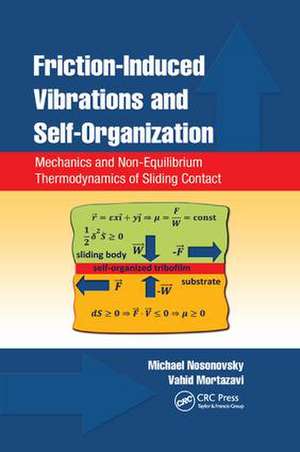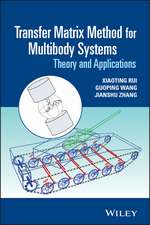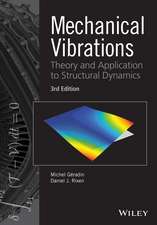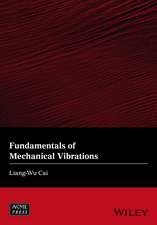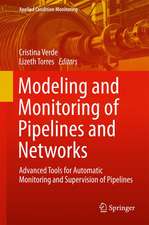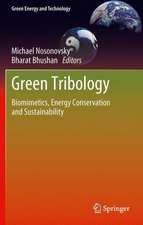Friction-Induced Vibrations and Self-Organization: Mechanics and Non-Equilibrium Thermodynamics of Sliding Contact
Autor Michael Nosonovsky, Vahid Mortazavien Limba Engleză Paperback – 9 mar 2018
Explore Friction from a Different Angle—as a Fundamental Force of Nature
The book begins with an exploration of friction as a fundamental force of nature throughout the history of science. It then introduces general concepts related to vibrations, instabilities, and self-organization in the bulk of materials and at the interface. After presenting the principles of non-equilibrium thermodynamics as they apply to the interface, the book formulates the laws of friction and highlights important implications. The authors also analyze wear and lubrication. They then turn their attention to various types of friction-induced vibration, and practical situations and applications where these vibrations are important. The final chapters consider various types of friction-induced self-organization and how these effects can be used for novel self-lubricating, self-cleaning, and self-healing materials.
From Frictional Instabilities to Friction-Induced Self-Organization
Drawing on the authors’ original research, this book presents a new, twenty-first century perspective on friction and tribology. It shows how friction-induced instabilities and vibrations can lead to self-organized structures, and how understanding the structure–property relationships that lead to self-organization is key to designing "smart" biomimetic materials.
| Toate formatele și edițiile | Preț | Express |
|---|---|---|
| Paperback (1) | 528.44 lei 6-8 săpt. | |
| CRC Press – 9 mar 2018 | 528.44 lei 6-8 săpt. | |
| Hardback (1) | 1407.29 lei 6-8 săpt. | |
| CRC Press – 9 aug 2013 | 1407.29 lei 6-8 săpt. |
Preț: 528.44 lei
Preț vechi: 743.13 lei
-29% Nou
Puncte Express: 793
Preț estimativ în valută:
101.11€ • 105.57$ • 83.69£
101.11€ • 105.57$ • 83.69£
Carte tipărită la comandă
Livrare economică 05-19 aprilie
Preluare comenzi: 021 569.72.76
Specificații
ISBN-13: 9781138074323
ISBN-10: 1138074322
Pagini: 333
Ilustrații: 9 Tables, black and white; 11 Illustrations, color; 102 Illustrations, black and white
Dimensiuni: 156 x 234 x 23 mm
Greutate: 0.66 kg
Ediția:1
Editura: CRC Press
Colecția CRC Press
ISBN-10: 1138074322
Pagini: 333
Ilustrații: 9 Tables, black and white; 11 Illustrations, color; 102 Illustrations, black and white
Dimensiuni: 156 x 234 x 23 mm
Greutate: 0.66 kg
Ediția:1
Editura: CRC Press
Colecția CRC Press
Cuprins
Introduction: Friction as a Fundamental Force of Nature in the History of Mechanics. Vibrations and Stability at the Bulk and at the Interface. Principles of Non-Equilibrium Thermodynamics and Friction. Fundamentals of Friction. Wear and Lubrication. Friction-Induced Instabilities and Vibrations. Friction-Induced Vibrations and Their Applications. From Frictional Instabilities to Friction-Induced Self-Organization. Self-Lubrication. Outlook. Index.
Notă biografică
Michael Nosonovsky is an assistant professor at the University of Wisconsin-Milwaukee. He received his M.Sc. from St. Petersburg Polytechnic University, Russia, and his Ph.D. in mechanical engineering from Northeastern University, Boston. He has also worked at Ohio State University and the National Institute of Standards and Technology. Michael’s interests include biomimetic surfaces, capillary effects, nanotribology, and friction-induced self-organization.
Vahid Mortazavi is a doctoral student at the University of Wisconsin-Milwaukee. He received his M.Sc. from Tarbiat Modares University in Tehran, Iran. Vahid’s research interests include friction, tribology, and heat transfer.
Vahid Mortazavi is a doctoral student at the University of Wisconsin-Milwaukee. He received his M.Sc. from Tarbiat Modares University in Tehran, Iran. Vahid’s research interests include friction, tribology, and heat transfer.
Recenzii
"The approach when friction is treated as a fundamental force of nature is definitely novel and very general. The relationship between friction-induced instabilities and friction-induced self-organization discussed in the book is an important topic ... . Much progress has been achieved in the field in the last decade and the book, reviewing the state of the art in the field, will be useful for a broad range of experts in the field of tribology. I also should emphasize the detailed treatment of self-healing materials in the book in the context of tribology, which is one of the hottest topics in the modern material science."
—Edward Bormashenko, Ariel University, Israel
"The book by Nosonovsky and Mortazavi presents a novel and intriguing approach to the studies of friction. The authors start with basic principles of non-linear dynamics and self-organization and apply them for analysis of friction in a daring attempt to deduce this phenomenon from general thermodynamics of non-equilibrium states. The authors succeeded to achieve clear and deep theory that, in particular, provides an interpretation of the events observed in recent experiments and explains a wide class of effects induced by friction."
—Eugene Kagan, The Weizmann Institute of Science, Israel
"While friction has been a largely discussed topic in different fields of science and engineering, there are lots of theoretical and practical questions that remain unanswered. This book takes a new theoretical approach in relating friction to very fundamental laws of nature. Hence, the book tries to show how real practical cases work under such theoretical observations. The book shows a very interesting combination of theoretical observations and practical necessities."
—Pradeep L. Menezes, University of Wisconsin-Milwaukee, USA
—Edward Bormashenko, Ariel University, Israel
"The book by Nosonovsky and Mortazavi presents a novel and intriguing approach to the studies of friction. The authors start with basic principles of non-linear dynamics and self-organization and apply them for analysis of friction in a daring attempt to deduce this phenomenon from general thermodynamics of non-equilibrium states. The authors succeeded to achieve clear and deep theory that, in particular, provides an interpretation of the events observed in recent experiments and explains a wide class of effects induced by friction."
—Eugene Kagan, The Weizmann Institute of Science, Israel
"While friction has been a largely discussed topic in different fields of science and engineering, there are lots of theoretical and practical questions that remain unanswered. This book takes a new theoretical approach in relating friction to very fundamental laws of nature. Hence, the book tries to show how real practical cases work under such theoretical observations. The book shows a very interesting combination of theoretical observations and practical necessities."
—Pradeep L. Menezes, University of Wisconsin-Milwaukee, USA
Descriere
Under certain conditions, friction can lead to the formation of new structures at the interface, including in situ tribofilms and various patterns, which can reduce friction and wear. This book presents a fresh perspective on friction and tribology by combining mechanical and thermodynamic approaches. The authors show how friction-induced instabilities and vibrations can lead to self-organized structures. They also explore how understanding the structure–property relationships that lead to self-organization can help engineers design "smart" biomimetic materials that are self-lubricating and self-healing.
